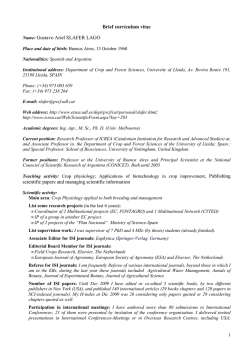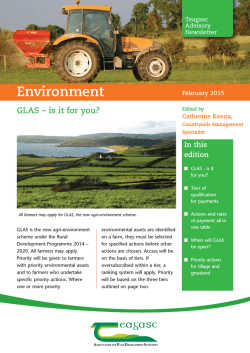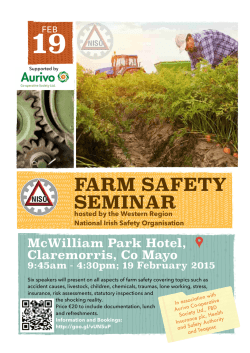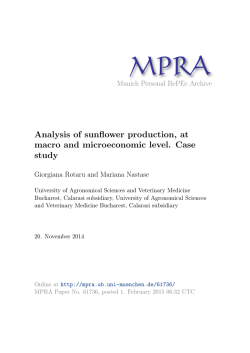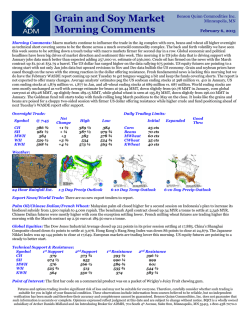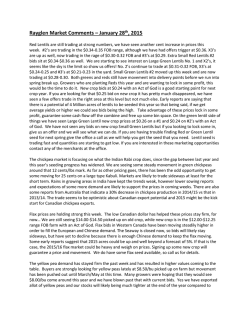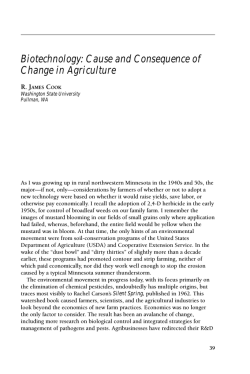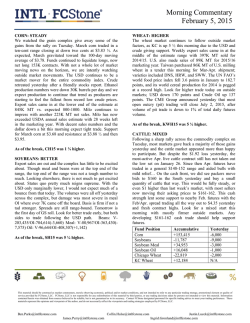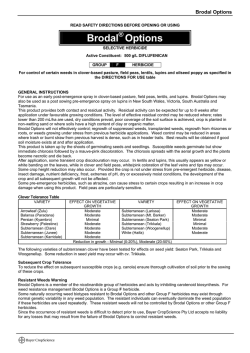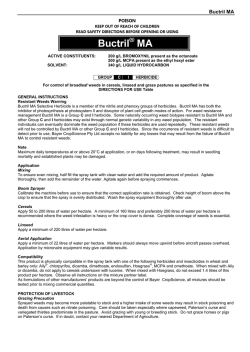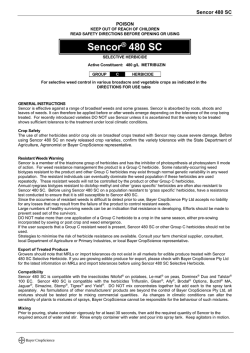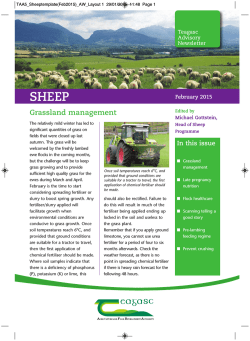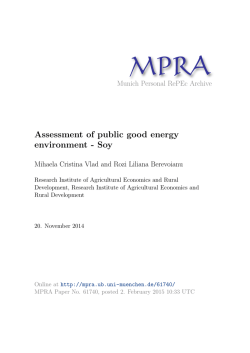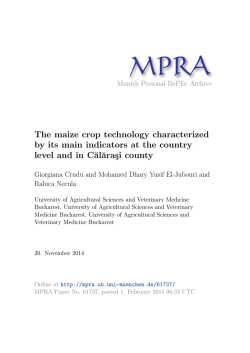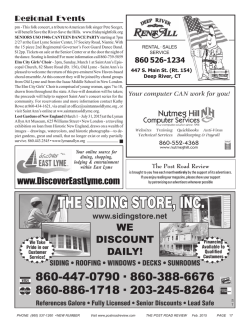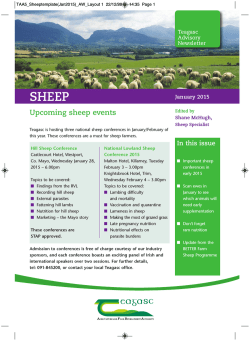
Tillage - Teagasc
TAA5_Tillage(Feb2015)_V_Layout 1 29/01/2015 10:26 Page 1 Teagasc Advisory Newsletter Tillage February 2015 Applying for Basic Payments Scheme and Greening Edited by Tim O’Donovan and Michael Hennessy, Tillage Specialists Farmers who need to comply with Greening rules must apply online for the Basic Payment Scheme (formerly the Single Farm Payment [SFP]). The process to set yourself up online is not very difficult. n Open your internet browser and log on to www.agfood.ie. n On this page, click onto “Register for online services”. n Once you have entered your details, the Department of Agriculture, Food and the Marine (DAFM) will verify your information and send you out a letter with details for full access. What information can you get online? Logging in to your account will give you details of all the previous SFP applications, all correspondences, maps, etc. In this edition n Applying online for payments n Winter crops The system will allow you to adjust maps as necessary. The system will allow you to view how Greening might affect your farm, i.e., crop diversification (the number and ratio of crops) and also how much Ecologial Focus Area (EFA) you have. The system will allow you to adjust maps and add/delete hedges or drains (see picture). Teagasc strongly advises all growers to register and interact with the online system. n Markets n Organic manures n Soil health n Crop budgets n Dates for the diary n Spring beans n Cereal varieties TAA5_Tillage(Feb2015)_V_Layout 1 29/01/2015 10:26 Page 2 TILLAGE Winter crops The autumn of 2014 was very mild, but it was wet through December and January. Establishment was excellent and all crops have tillered well. Winter barley grew strongly over the autumn and may be quite advanced by late February. Preliminary results from recent nitrogen (N) application research in winter barley show that in the past two seasons there was no advantage, or disadvantage, to applying N earlier than the traditional timing of early to mid March. This gives growers a wide window in which to apply the first N. The research did show that applying a higher proportion of N in the first split gave reduced yields, largely due to reduced recovery of the fertiliser by the crop. It is advised that not more than approximately 30% of the total amount of N be applied in the first split. However, for very advanced crops that have reached GS 30 by late February, it may be prudent to apply N as soon as growth resumes to avoid N deficiency. Again, the amount applied should not be excessive to avoid increasing the risk of lodging. Action: Where applying N before the end of February, restrict the application rate to approximately 30% of the total. If the weather is cold and no growth is expected, target to apply the first split of N by mid March. Latent (and some active) mildew, rhyncho and net blotch are evident in most crops. These may pose an increased threat earlier than normal, if weather conditions suit. Where mild conditions prevail in late February and disease is active, consider applying a fungicide. Consult your adviser before applying this fungicide. Many winter wheat crops are showing high levels of active septoria this year and this may make the start of the disease control programme more difficult than usual. However, fungicides should not be applied until March. Generally delay N inputs onto wheat until close to the middle of March. Oilseed rape Oilseed rape has come through the winter well with very few reports of excessive pigeon grazing. Many crops have big canopies with a Green Area Index (GAI) of up to three. Assess your canopy size using a GAI tool on a smartphone in mid February. n Delay the first N application to canopies that are >1 until March. n Apply N to crops (or parts of crops) with a GAI of <1 in mid to late February. n Light leaf spot (LLS) was the most prominent disease in oilseed rape in 2014. Crops were stunted in many cases due to early infection (January/February). Recent samples from Oak Park indicate an increase in disease levels and all crops should be checked immediately. n Collect 30-40 leaves through the crop and place in a plastic bag at 10-15oC for four to five days. This encourages sporulation so the disease can be seen on the plant. The threshold for spraying is when >15% of plants have symptoms. Collect 30-40 leaves through the crop and place in a plastic o bag at 10-15 C for four to five days. This encourages sporulation of LLS so the disease can be seen on the plant. TAA5_Tillage(Feb2015)_V_Layout 1 29/01/2015 10:26 Page 3 FEBRUARY 2015 Markets Cereal prices rebounded from the lows during harvest but have weakened in the past few weeks. Irish traders are reporting that despite the relatively strong international markets there are few Irish buyers of native grains in the early part of the year. The EU publication Strategie Grains, published in mid January, states that forecasts for wheat are better than expected due to higher exports; however, they are forecasting the prospects for 2015/16 as Organic manures One thousand gallons of pig slurry is equivalent to a bag/ac of 19–7–20 and can add other soil benefits such as increased soil organic matter and improved micronutrient levels. Target organic manures on low fertility sites first. To maximise the nutrient value of organic fertilisers and reduce nitrogen (N) losses, it is essential to consider the following: n ensure thatslurry is well agitated before application; n apply evenly and accurately at 2,000 gallons/ac; n incorporate within four to six hours to maximise N recovery; and, n 2,000 gallons/ac of pig slurry can reduce fertiliser cost by €50/ac. heavy, with increased stocks compared to last year. The publication predicts that barley is heavy, with higher stocks and reduced consumption likely to weigh on prices. Forward prices for grain (Nov. 15) have remained relatively steady and represent an opportunity for growers who are aware of their costs. In general, don’t over commit and it is prudent not to sell forward more than half of your expected production. Soil health and fertilisers If you don’t have a current soil analysis (completed within the last five years) then resample these fields immediately. Also, where a section of a field is preforming poorly, sample this area, as a deficiency can be masked within a whole field sample. Crop budgets 2015 The Teagasc Costs and Returns 2015 is available online at www.teagasc.ie or from local Teagasc offices, but remember your own figures could vary by €80/ac above or below Teagasc estimates depending on your situation. Dates for your diary Spring seminars Winter cereal walks Spring seminars are continuing in February in Kilkenny, Offaly, Kerry, Kildare, Tipperary, Galway, Donegal and Wicklow. Among the topics covered this year are Greening, Young Farmers, GLAS, beans and current crop management. Contact your local office for details. Regional field crop walks will be held in Carlow, Meath, Kilkenny, Wexford, Offaly and Cork from February 11. Current crop management will be discussed including fertilisation of oilseed rape and cereals, disease control in winter wheat and barley, etc. Contact your local office for details. TAA5_Tillage(Feb2015)_V_Layout 1 29/01/2015 10:26 Page 4 TILLAGE Spring beans The recent CAP reform proposals included a protein crop subsidy of €250/ha and show a similar margin to spring barley in the Teagasc Cost and Returns 2015. Beans can be sown from now on and ideally before March 1. Sow to a depth of at least 7.5cm (3”) or greater to avoid excessive crow damage. The main variety available this year is Fuego, while Fury has also proven to be reliable in DAFM trials. The seeding rate in Table 1 is to achieve 30 seeds/m2 at 550 TGW. *Take note of the TGW on the seed lot as TGW can vary from 480-600. Weed control Use Nirvana at 3.0-4.5L/ha for weed control in beans. It is a pre-emergence spray, which must be applied before the beans are within 13mm of the soil surface. Apply (pre-emerge) Lingo 1.75L/ha plus Nirvana 3.0L/ha (or add 800g ai/ha PDM – off label recommendation so check product before use). A fine seedbed is recommended as with all soil residual herbicides. Table 1: Bean variety info 2015 (PGRO UK list 2015) Variety Standing Shortness Downey ability of straw mildew seeding rate 99 8 6 5 195kg/ha* Fury 101 7 7 6 195kg/ha* Boxer 102 8 6 4 195kg/ha* Fuego Yield Suggested Spring wheat varieties There are two new additions to the DAFM Recommended List this year. Spring wheat can be sown from February (in good conditions) up to mid-late March. Early sowing in good conditions will give the crop the best possible start and can result in higher yields. Variety Relative yield Septoria Mildew Seed rate stone/ac+ Sparrow 101 6 6 11.4 Trappe 99 6 5 10.5 RGT Doubleshot 107 (6) (5) 11.2 Qunitus 109 (6) (8) 11.7 +Based on a target of 325 plants/m2 and 85% germination For further information on any issues raised in this newsletter, or to access other enterprise newsletters, please contact your local Teagasc adviser or see www.teagasc.ie. Produced by Think Media. Table 2: Spring wheat varieties
© Copyright 2026
